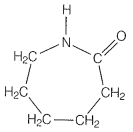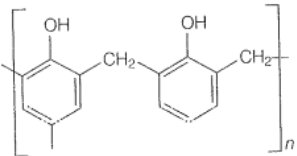Which of the following polymer can be formed by using the following monomer unit?

1. Nylon-6,6
2. Nylon-2-nylon-6
3. Melamine polymer
4. Nylon-6

Match the polymer of Column I with the correct monomer of Column II
| Column I | Column II |
| A. High-density polymer | 1. Isoprene |
| B. Neoprene | 2. Tetrafluoroethene |
| C. Natural rubber | 3. Chloroprene |
| D. Teflon | 4. Ethene |
Codes
| A | B | C | D | |
| 1. | 2 | 3 | 4 | 1 |
| 2. | 3 | 1 | 4 | 2 |
| 3. | 4 | 3 | 1 | 2 |
| 4. | 4 | 3 | 2 | 1 |
Match the polymers given in Column I with their chemical names given in Column II.
| Column I | Column II |
| A. Nylon-6 | 1. Polyvinyl chloride |
| B. PVC | 2. Polyacrylonitrile |
| C. Acrilan | 3. Polycaprolactum |
| D. Natural rubber | 4. cis-polyisoprene |
Codes
| A | B | C | D | |
| 1. | 2 | 3 | 4 | 1 |
| 2. | 3 | 1 | 2 | 4 |
| 3. | 1 | 4 | 3 | 2 |
| 4. | 4 | 3 | 2 | 1 |
Match the polymers given in Column I with their commercial names given in Column II.
| Column I | Column II |
| A. Polyester of glycol and phthalic acid | 1. Novolac |
| B. Copolymer of 1, 3-butadiene and styrene | 2. Glyptal |
| C. Phenol and formaldehyde resin | 3. Buna-S |
| D. Copolymer of 3-butadiene and acrylonitrile | 4. Buna-N |
Codes
| A | B | C | D | |
| 1. | 2 | 3 | 1 | 4 |
| 2. | 3 | 1 | 4 | 2 |
| 3. | 2 | 4 | 3 | 1 |
| 4. | 4 | 3 | 2 | 1 |
Match the following:
| Column I | Column II |
| A. Bakelite | 1. Squeeze bottles |
| B. Low-density polyethylene | 2. Unbreakable crockery |
| C. Melamine-formaldehyde resin | 3. Tyre, cords |
| D. Nylon- 6 | 4. Electrical switches |
Codes
| A | B | C | D | |
| 1. | 2 | 3 | 4 | 1 |
| 2. | 4 | 1 | 2 | 3 |
| 3. | 1 | 4 | 3 | 2 |
| 4. | 4 | 3 | 2 | 1 |
Match the polymers given in Column I with the preferred mode of polymerization followed by their monomers in Column II.
| Column I | Column II | ||
| A. | Nylon- 6, 6 | 1. | Free radical polymerisation |
| B. | PVC | 2. | Ziegler-Natta polymerisation or coordination polymerisation |
| C. | HDP | 3. | Anionic polymerisation |
| 4. | Condensation polymerisation | ||
Codes
| Options: | A | B | C |
| 1. | 2 | 3 | 4 |
| 2. | 3 | 1 | 2 |
| 3. | 1 | 4 | 3 |
| 4. | 4 | 1 | 3 |
Match the polymers given in Column I with the type of linkage present in them given in Column II.
|
Column I |
Column II |
| A. Terylene B. Nylon C. Cellulose D. Protein E. RNA |
1. Glycosidic linkage |
Codes
| Options: | A | B | C | D | E |
| 1. | 2 | 5 | 1 | 4 | 3 |
| 2. | 3 | 1 | 5 | 2 | 4 |
| 3. | 5 | 4 | 3 | 2 | 1 |
| 4. | 4 | 3 | 2 | 1 | 5 |
Match the materials given in Column I with the polymers given in Column II.
| Column I | Column II |
| A. Natural rubber latex | 1. Nylon |
| B. Wood laminates | 2. Dacron |
| C. Ropes and fibers | 3. Urea-formaldehyde resins |
| D. Polyester fabric | 4. cis-polyisoprene |
Codes
| A | B | C | D | |
| 1. | 2 | 3 | 4 | 1 |
| 2. | 3 | 4 | 1 | 2 |
| 3. | 1 | 4 | 3 | 2 |
| 4. | 4 | 3 | 1 | 2 |
Match the polymers given in Column I with their repeating units given in Column II.
|
Column I |
Column II |
| A. Acrilan B. polystyrene C. Novolac D. Buna-N |
1. 3. |
Codes
A B C D
1. 2 3 4 1
2. 3 1 4 2
3. 1 4 3 2
4. 4 3 2 1
Given below are two statements:
| Assertion (A): | Rayon is a semisynthetic polymer and is taken as a better choice than cotton fabric. |
| Reason (R): | Mechanical and aesthetic properties of cellulosic can be improved by Acetylation. |
| 1. | Assertion and Reason both are correct statements But reason does not explain Assertion. |
| 2. | Assertion and Reason both are correct statements and Reason explains the Assertion. |
| 3. | Assertion is the correct statement and Reason is the wrong statement. |
| 4. | Assertion is the wrong statement and reason is the correct statement. |







